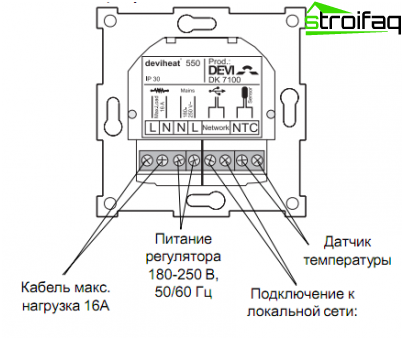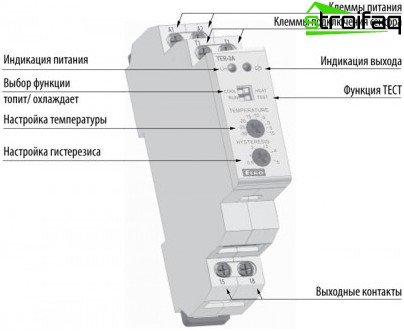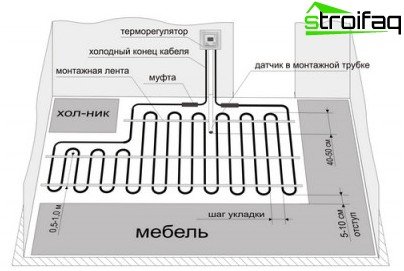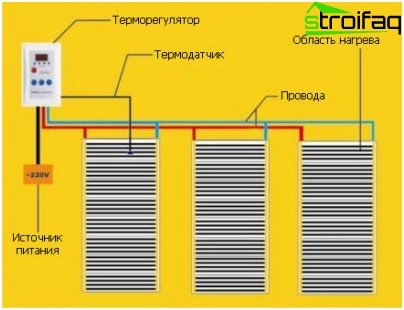Thermostat for underfloor heating
So, in your house it is planned to equip a warm floor. This task can be done by any owner! Infrared film can be used in any room and installed under any floor covering – linoleum, laminate, carpet, parquet or tile. And only the thermostat for the warm floor remains in sight. This unit is the most important element of the film system..
Content
- Thermostat for underfloor heating
- Controller functions
- Types of thermostats for underfloor heating
- Using thermostats for underfloor heating
- Thermostat mounting
Thermostat for underfloor heating
The temperature regulator (thermostat) is an electronic device that is designed to control the operation of the heating system in order to maintain the set temperature on the surface of the warm floor and in the housing. Many of the thermostats, in addition to the floor temperature sensor, also have a built-in sensor in their configuration, which measures the temperature and humidity.

Thermostat design for underfloor heating
The simplest models are equipped with one sensor and a special knob to set the desired temperature. High-end controllers are equipped with a liquid crystal display, it is possible to set the desired temperature when time changes and control using a computer.
Regardless of the model, the temperature on the digitized scale is set in a wide range from 10 to 40 degrees Celsius. Thermostats are made of light but durable plastic and meet all the safety requirements established for electrical appliances. Excludes accidental shutdown or turning on the device.
Controller functions
The use of temperature controllers for floor heating helps to create the most comfortable microclimate in the room and significantly reduce electricity costs. In this case, the situation of overheating or underheating is completely eliminated..
After installing the controller, there is no need to open windows to adjust the temperature, since the device maintains the temperature with high accuracy – up to one degree Celsius.

Thermostat is a multifunctional device that allows you to set the desired mode, control the operation of the system, protect against overheating
The underfloor heating controller acts as a protective device. If there is a sharp surge in voltage, accidental mechanical damage or overheating of the cable, there is a possibility of a short circuit, which can cause the entire heating system to fail. The thermostat prevents such overloads, the protective relay trips instantly, and the power supply is cut off.
Thermostats, depending on the time of year, operate in different modes, but at the same time, the devices are easy to use and multifunctional, as well as an inherent indicator such as intelligence.
Types of thermostats for underfloor heating
Today on the market there are a variety of modifications of temperature controllers, ranging from simple devices to devices that are equipped with additional sensors. Among the devices that are designed to control floor heating, there are such basic types of temperature controllers as mechanical, electronic, programmable and touch.
- A mechanical floor temperature controller is the easiest and cheapest option. Most often, temperature control is carried out at the level of touch. This model is ideal to maintain the temperature within small areas – for example, in the bathroom, bathroom, shower, when there is no need for saving electricity.
- Electronic temperature controllers differ from mechanical ones by the presence of a liquid crystal display, which allows you to see the exact temperature on the screen. This figure seems insignificant at first glance. But, according to official sources, for legs ideal temperature is considered to be 26 – 27 degrees Celsius. That’s why you need to accurately maintain the temperature in this range..
- Programmable controllers allow you to independently set the time the system is turned on and off, and at different times to maintain different temperatures. Almost all models presented on the domestic market are quite possible to program for a week and for a day.
- It is advisable to use a touch thermostat for a water floor heating, when it comes to large heated areas, and it is advisable to save electricity. The thermostat will duplicate the operating time and temperature values that have been set by the user until these parameters are changed.
Within each type, thermostats of different manufacturers may additionally have useful functions..
Using thermostats for underfloor heating
Underfloor heating controllers are used everywhere in the installation of ventilation, air conditioning and heating systems in industrial, agricultural, commercial and residential buildings. Thermostats can be installed in buildings that already exist, or in buildings under construction for different purposes and different storeys.
Such equipment implies a convenient setting: the thermostat can be placed in old or new heating systems, since the device is adapted for useful operation in various conditions.

An example of installing a thermostat – installing a heated floor in a kitchen
Thermostats provide a comfortable temperature, as they reduce the excessive supply of heat from the heating system at the time of heat from the sun. As soon as it gets a little warmer on the street, energy consumption is significantly reduced.
Controllers are primarily needed in places where the temperature regime changes during the day:
- in the kitchen, where additional heat comes from the gas stove;
- in a room on the sunny side, in which the temperature rises during the day through natural heating;
- in the living room, because residents and guests gather here all the time;
- in the houses on the upper floors, since warm air rises from the bottom up the stairs and there is often nothing to breathe.
Thermostat mounting
Thermostats must be installed on the wall in the room that you plan to heat. Sunlight should not fall on this wall, the regulator should not be covered with curtains and curtains..
The connection diagram of the thermostat for underfloor heating depends on the model of the controller for underfloor heating. In general, you first need to de-energize the wiring. It must be remembered that device malfunctions that arise as a result of improper connection are not covered by the manufacturer’s warranty.
The list of tools and materials that are necessary for installation:
- corrugated plastic tube that has a diameter of at least 16 millimeters;
- slotted screwdriver;
- standard plastic mounting box.

Thermostat connection diagram for film infrared floor
It is recommended that the temperature regulator be installed at the end of the installation of the system a warm floor. To avoid damage, the temperature controller must be left in the packaging box until it is directly installed. Avoid mechanical impact on the display..
All contacts that are to be connected are located under the front cover of the device, access to which occurs after removing the cover, which is attached to the screws. You can remove it with a thin slotted screwdriver, alternately pressing on the latches that are located below and above the front cover of the controller.
The device is installed in the junction box and fixed with two screws that are located on the horizontal axis of the regulator. After that, you need to install the display and tighten the cover without tightening the screws. Thus, connecting a thermostat to a warm floor does not take much time!
Now it’s clear why it is recommended to install a thermostat when installing a system of warm floors. The device helps maintain the required temperature in the room and save energy. The most expensive models are equipped with additional options that allow you to control humidity.


